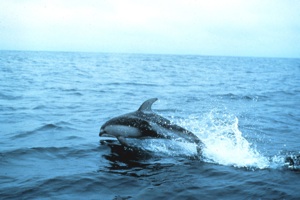Marine Mammal Species Description
Atlantic White-Sided Dolphin
Lagenorhynchus acutus
(Gray, 1828)

Photo credit: Pacific White-Sided Dolphin, Tom Kieckhefer, NOAA Photo Library
Classification
Order: Cetacea
Family: Delphinidae
Alternate Common Names:
Status: protected under MMPA
Description:
Length: males: 7.5-9.2 ft (2.3-2.8 m); females: 6.2-7.9 ft (1.9-2.4 m)
Weight: 397-507 lbs (180-230 kg)
Male Atlantic white-sided dolphins are larger than females. They are a robust dolphin with a short beak, falcate dorsal fin, and ridges (keels) that extend from the fluke up on to the body. The tops, flippers and flukes of these dolphins are dark gray or black. A large part of their sides from their eyes to their fluke is a lighter shade of pale. Their bellies are white. They also have one white or light patch on the middle of their side below their dorsal fin and a yellow patch on the top half of their side starting at their dorsal fin and extending to their fluke.
Habitat:
Atlantic white-sided dolphins occur in the deep waters of the continental shelf and continental slope. They occur mostly in waters with depths ranging from 328-985 ft (100-300 m), but also have been seen in shallower waters. They are found in schools of a few individuals to schools numbering in the hundreds. Average sizes of the schools depend on where in the Atlantic they are found. Off the coast of the northeast United States, the average school size is about 40 individuals.
Feeding:
These dolphins eat small fish and squid. They have been documented working together to herd fish. Typically, they surface every 10-15 seconds to breathe, but have been recorded in a dive for up to 4 minutes.
Reproduction:
Adult Atlantic white-sided dolphins become sexually mature at around 6-12 years of age for females and 7-11 years for males. These ages correspond to size ranges of 6.6-7.2 ft (2-2.2 m) for females and about 7.2-7.5 ft (2.2-2.3 m) for males. Some females may give birth every year. The gestation period is approximately 11 months. Calves are typically born in mid-summer. Females nurse their calves for about 1.5 years.
Other:
The maximum documented life span of an Atlantic white-sided dolphin is 22 years for males and 27 years for females.
Distribution / Range:
Atlantic white-sided dolphins occur in cold temperate and polar regions of the northern Atlantic Ocean. Off the coast of the United States, they typically occur from Massachusetts northward.
Similar species:
They are similar to other species in the genus Lagenorhynchus. Only the white-beaked dolphin (Lagenorhynchus albirostris) occurs in the same area as the Atlantic white-sided dolphin and the striking color pattern of the Atlantic white-sided dolphin should make it distinguishable.
Notes:
References:
Brownell, R.L., Jr. 1999. Atlantic white-sided dolphin, Lagenohynchus acutus. In The Smithsonian Book of North American Mammals. Wilson, D.E. and S. Ruff, eds., 276-277. Smithsonian Institution in association with the American Society of Mammologists, Washington DC.
Cipriano, F. 2009. Atlantic white-sided dolphin - Lagenorhynchus acutus. In: Encyclopedia of Marine Mammals 2nd Ed. Perrin W.F., B. Würsig, and J.G.M. Thewissen, eds. Academic Press, New York, pp. 56-58.
Culik, B. 2010. Odontocetes. The toothed whales: "Lagenorhynchus acutus". UNEP/CMS Secretariat, Bonn, Germany. http://www.cms.int/reports/small_cetaceans/index.htm. Accessed January 2012.
Hammond, P.S., Bearzi, G., Bjørge, A., Forney, K., Karczmarski, L., Kasuya, T., Perrin, W.F., Scott, M.D., Wang, J.Y., Wells, R.S. & Wilson, B. 2008. Lagenorhynchus acutus. In: IUCN 2011. IUCN Red List of Threatened Species. Version 2011.2. www.iucnredlist.org. Downloaded on 09 January 2012.

 Marine Mammals of Georgia
Marine Mammals of Georgia